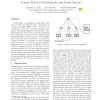Free Online Productivity Tools
i2Speak
i2Symbol
i2OCR
iTex2Img
iWeb2Print
iWeb2Shot
i2Type
iPdf2Split
iPdf2Merge
i2Bopomofo
i2Arabic
i2Style
i2Image
i2PDF
iLatex2Rtf
Sci2ools
ICCAD
1995
IEEE
1995
IEEE
Activity-driven clock design for low power circuits
In this paper we investigate activity-driven clock trees to reduce the dynamic power consumption of synchronous digital CMOS circuits. Sections of an activity-driven clock tree can be turned on/o
by gatingthe clock signals duringthe active/idle times of the clocked elements. We propose a method of obtaining the switching activity patterns of the clocked circuits during the high level design process. We formulate three novel activity-driven problems. The objective of these problems is to minimize system's dynamic power consumption. We propose an approximation algorithm based on recursive matching to solve the clock tree construction problem. We solve the gate insertion problems with an exact algorithm employing the dynamic programming paradigm. Finally, we present experimental results that verify the e
ectiveness of our approach. Our work in this paper is a step in understanding how high level decisions (e.g. behavioral design) can a
ect a low level design (e.g. clock design).
| Added | 26 Aug 2010 |
| Updated | 26 Aug 2010 |
| Type | Conference |
| Year | 1995 |
| Where | ICCAD |
| Authors | Gustavo E. Téllez, Amir H. Farrahi, Majid Sarrafzadeh |
Comments (0)

